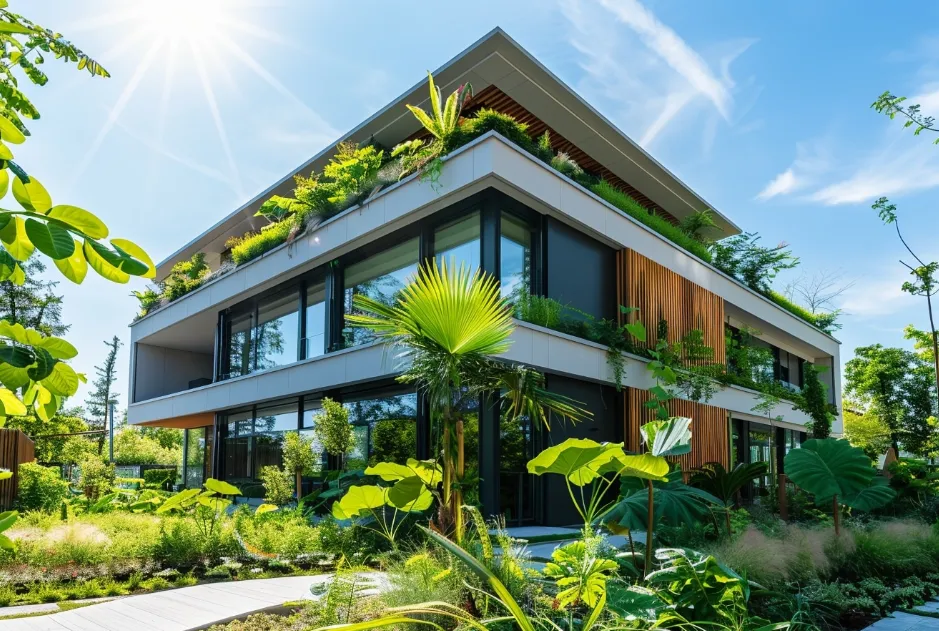Sustainability has become more than just a buzzword in today’s society; it is a necessity. The real estate sector, which significantly impacts the environment, is increasingly turning toward eco-friendly practices and innovations. Green buildings and eco-friendly investments are paving the way for a sustainable future, aligning with global goals to mitigate climate change and reduce carbon footprints. As the industry evolves, the integration of technology, innovative materials, and energy-efficient systems is reshaping how we design, build, and inhabit our spaces.
Understanding Sustainable Real Estate
Sustainable real estate involves designing, constructing, and operating properties in ways that minimize environmental impact while maximizing efficiency. This concept extends beyond just reducing energy consumption; it encompasses water conservation, waste management, air quality improvement, and the use of renewable energy sources. Sustainable real estate is driven by the need to combat climate change and create healthier environments for occupants.
Green buildings, a cornerstone of sustainable real estate, are designed to meet specific environmental standards. These structures incorporate renewable energy systems, energy-efficient designs, and eco-friendly materials. Certification systems like LEED (Leadership in Energy and Environmental Design) and BREEAM (Building Research Establishment Environmental Assessment Method) provide frameworks for evaluating a building’s sustainability.
The Rise of Green Buildings
Green buildings are gaining traction as governments, businesses, and consumers prioritize sustainability. Several factors are fueling this rise:
- Regulatory Push:
Governments worldwide are implementing stringent environmental regulations and incentives to encourage sustainable construction. Policies such as carbon taxes, renewable energy mandates, and subsidies for green initiatives are motivating developers to adopt eco-friendly practices. - Market Demand:
Modern consumers, especially millennials and Gen Z, prefer sustainable living spaces. These demographic groups are more environmentally conscious and willing to pay a premium for green features like solar panels, energy-efficient appliances, and sustainable construction materials. - Economic Benefits:
Green buildings often result in significant cost savings over time due to reduced energy and water consumption. Lower operating costs, coupled with potential tax incentives, make sustainable real estate an attractive investment. - Corporate Responsibility:
Companies are embracing sustainability to align with corporate social responsibility (CSR) goals. Green office spaces improve employee well-being, boost productivity, and enhance brand reputation.
Technological Innovations in Sustainable Real Estate
Technology plays a crucial role in driving the sustainable real estate movement. Innovations are making it easier to design, construct, and manage eco-friendly properties. Some key technologies include:
- Smart Building Systems:
IoT-enabled devices allow real-time monitoring and optimization of energy use, water consumption, and indoor air quality. Smart thermostats, lighting systems, and energy management platforms help reduce waste and improve efficiency. - Renewable Energy Integration:
Solar panels, wind turbines, and geothermal systems are becoming standard in green buildings. Advancements in battery storage technology ensure renewable energy can be used efficiently, even during non-peak production times. - Sustainable Materials:
Eco-friendly materials, such as recycled steel, bamboo, and low-carbon concrete, are replacing traditional building materials. Innovations like self-healing concrete and bioplastics are revolutionizing construction processes. - AI and Data Analytics:
Artificial intelligence and data analytics are optimizing building performance. Predictive models can identify inefficiencies, recommend energy-saving measures, and track environmental impact metrics. - 3D Printing:
3D printing technology is reducing construction waste and enabling the use of sustainable materials. It also allows for faster, more cost-effective construction processes.
Eco-Friendly Investments: The New Frontier
The financial sector is increasingly recognizing the potential of eco-friendly investments in real estate. Sustainable properties are not just ethically sound; they are also financially viable. Investors are turning to green real estate as a way to balance profit with purpose. Key trends in eco-friendly investments include:
- Green Bonds:
Green bonds are fixed-income securities that fund environmentally friendly projects. In real estate, these bonds finance the construction of green buildings, renewable energy systems, and other sustainability initiatives. - Real Estate Investment Trusts (REITs):
Green REITs focus on environmentally sustainable properties. These trusts offer investors a chance to participate in the green real estate market while enjoying the benefits of diversification and liquidity. - Impact Investing:
Impact investors prioritize projects that generate measurable social and environmental benefits alongside financial returns. Green real estate projects, such as affordable housing with sustainable features, align perfectly with this investment approach. - Carbon Credit Markets:
Investors are exploring carbon credit markets as a way to offset emissions from real estate projects. By purchasing carbon credits, developers can balance the environmental impact of their properties.
Benefits of Sustainable Real Estate
Sustainable real estate offers numerous advantages for all stakeholders:
- Environmental Benefits:
Green buildings reduce greenhouse gas emissions, conserve natural resources, and minimize waste. They contribute to a cleaner, healthier planet. - Economic Advantages:
Energy-efficient buildings lower utility bills and operating costs. They also have higher occupancy rates and resale values compared to traditional properties. - Social Impact:
Sustainable properties provide healthier indoor environments, improving the well-being of occupants. Features like improved air quality, natural lighting, and ergonomic designs enhance quality of life. - Resilience:
Green buildings are often better equipped to withstand climate-related challenges, such as extreme weather events. Features like rainwater harvesting and renewable energy systems increase their resilience.
Challenges and Opportunities
Despite its promise, the transition to sustainable real estate is not without challenges. High upfront costs, lack of awareness, and limited access to green technologies are significant barriers. However, these challenges also present opportunities for innovation and collaboration.
- Education and Awareness:
Raising awareness about the benefits of sustainable real estate is essential. Governments, industry leaders, and educational institutions can play a role in educating stakeholders about eco-friendly practices. - Policy Support:
Policymakers can incentivize sustainable construction through tax breaks, grants, and streamlined approval processes for green projects. Public-private partnerships can accelerate the adoption of eco-friendly technologies. - Technological Advancements:
Continued innovation in materials, energy systems, and construction techniques will make sustainable real estate more accessible and affordable. - Collaboration:
Collaboration between architects, developers, investors, and communities is crucial for creating sustainable real estate solutions that meet diverse needs.
The Role of Consumers
Consumers play a pivotal role in driving the future of sustainable real estate. By choosing eco-friendly properties and demanding transparency about environmental impact, buyers and tenants can influence the market. Educated consumers are more likely to support sustainable practices, making it essential for the real estate sector to engage and inform them.
Looking Ahead: The Future of Sustainable Real Estate
The future of sustainable real estate is bright. Green buildings and eco-friendly investments are not just trends; they are essential components of a sustainable future. As the world grapples with the realities of climate change, the real estate industry has an opportunity to lead by example.
In the coming years, we can expect:
- Increased Adoption of Net-Zero Buildings:
Net-zero buildings, which produce as much energy as they consume, will become the norm rather than the exception. - Integration of Circular Economy Principles:
The real estate sector will increasingly adopt circular economy principles, focusing on reducing waste and reusing materials. - Expansion of Green Financing:
The financial sector will continue to innovate, offering more tools and products to support sustainable real estate projects. - Focus on Resilient Communities:
Sustainable real estate will prioritize community resilience, integrating green spaces, transportation solutions, and social infrastructure.
Conclusion
The future of sustainable real estate lies in our collective ability to innovate, collaborate, and prioritize long-term environmental goals over short-term profits. Green buildings and eco-friendly investments represent a transformative shift in how we interact with the built environment. By embracing sustainability, the real estate industry can contribute to a healthier planet, stronger communities, and a more resilient future. The journey toward sustainable real estate is not just an investment in property; it is an investment in the future of our world.



